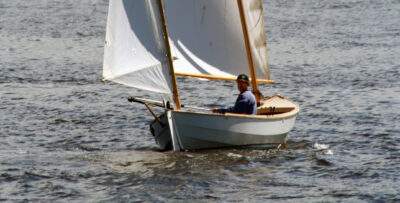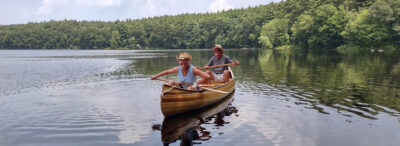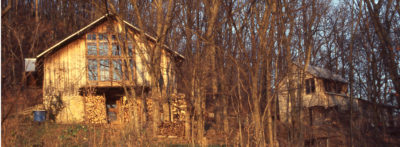A few years ago, I headed out for a solo afternoon sail on Puget Sound aboard my Caledonia Yawl, ALISON. It was a weekday and there was only a handful of trailers parked in the lot by the launch ramp at Meadow Point. The light summer breeze was just right for the ample spread of the lug main and, after I cleared the breakwater guarding the ramp, ALISON slipped briskly through the corrugated water.
 Laurie Cunningham
Laurie CunninghamAfter setting sail, I headed across Puget Sound toward Bainbridge Island. (The photographs here were taken in the same location but on different occasions. They closely resemble the scenes in the events conveyed in this account.)
The only other boat on the water, a sailing skiff, was about 1⁄4 mile from shore. We crossed tacks close enough that I could say hi to what appeared to be a father and a daughter in her early teens. In the northwesterly breeze, I was on a starboard tack headed west across the sound and they were on a port tack heading north into open water beyond Meadow Point.
 Christopher Cunningham
Christopher CunninghamAfter I’d crossed tacks with the sailing skiff, its sail was still visible for a while, a bit of white off Meadow Point, the wooded shoreline at left. The launch ramp is at the right at the edge of the marina’s line of masts.
I made good time with a summer breeze that provided decent boat speed without kicking up a chop. It was easy sailing, but I regularly scanned the horizon, a practice picked up from my father when he taught me how to sail.
 Laurie Cunningham
Laurie CunninghamAlthough there were few other boats out, I frequently scanned the horizon and often looked over the stern. What caught my attention was the absence of the skiff’s sail.
At one point I saw no other boats around me, not even when I looked aft. The skiff should have been somewhere astern, but I didn’t see it anywhere. The father and his daughter couldn’t have disappeared, so I came about and headed east on a reach toward the area where I had expected to see them.
After I had sailed 100 yards or so, I caught sight of the skiff with its crew clinging to its capsized hull. There was no centerboard or daggerboard showing. If it had been lowered while they were sailing, it had slipped back into its trunk during the capsize and couldn’t be used to right the boat. If they hadn’t deployed it, its absence may have been the cause of their capsize.
When I reached the pair, I rounded up, but ALISON was carrying too much speed. I reached over the starboard side and grabbed the outstretched arm of the father. Even as he was saying “Get her first,” I pulled him off his boat. ALISON came to a stop a few yards upwind, and I helped him crawl over the rail.
I pushed the main’s boom to port to bring the bow around, sailed a loop back to coast alongside the skiff, and brought the daughter on board. I retrieved an aluminized emergency blanket that I kept tucked under the foredeck and the father wrapped it around the shivering girl. By the time I had the two of them settled aboard, an outboard fishing skiff and a cabin cruiser had arrived, and their crews set about trying to right the capsized skiff. I sailed on a run to get my cold and wet passengers back to the launch ramp, about a mile away.
When we were about halfway there, a Coast Guard Zodiac that had emerged from the breakwater raced by about 50 yards away to port of ALISON. I pulled my VHF radio out of my PFD pocket and turned it on. I had only used it to monitor vessel traffic on Channel 14 and, while I knew the channel to use and the protocols for hailing another vessel, I’d never transmitted a call. I froze and, in a pointless gesture that embarrasses me still, I held my radio up so the Coasties could see it. Call me? The Zodiac was already long gone and soon joined the boats around the capsized skiff. After a stop there it turned around and caught up with ALISON when we were just a few dozen yards from the launch ramp. Assured that everyone was safe, they motored in ahead of ALISON.
A fire truck was waiting at the ramp for the father and daughter. I docked and handed my passengers over to the medics. Several minutes later, the other good Samaritans towing the still-capsized sailboat eventually arrived at the dock. I helped them get the skiff righted.
I came away from that incident with mixed feelings. I was, of course, glad that I could help, and I appreciated the attentiveness I’d learned from my father. But I was surprised and disappointed that things that I knew how to do had eluded me when I needed to put them to use. I knew that I should have rounded-up downwind of the capsized skiff to come to a stop alongside it, but it has been decades since I had practiced by throwing a cushion overboard and sailing around to retrieve it. I knew that I could have turned the VHF radio to Channel 16 and hailed the Coasties, but on the occasions that I was boating in the company of another boat which also had a VHF, I didn’t take advantage of the opportunities to practice making calls.
The rescue was, at best, an illuminating experience in how the mind works (my mind, at least). Sometimes even the simplest bits of knowledge can be safely stored in memory and recalled at a moment’s notice if recollection is all that’s required. But turning knowledge into action requires creating the pathway for electrical impulses to reach the muscles. It’s that way with music. I may know a tune by heart and be very familiar with all the notes and chords on the sheet music, but it’s not until I put in the practice on the piano that I can play it and eventually have the joy of listening to the music my hands create without having to bridge the gap between knowledge and action. As I put in the practice with my rescues and VHF, I’ll be able to do what needs to be done without hesitation and avoid making such blunders as tearing a father away from his child or holding my radio up as if it was meant to be used as a semaphore.
![]()













Always good to think about what could have been done better, but at least you were thinking and watching enough to realize something was wrong and look for them. I rescued a kayaker in April who capsized a sit-in kayak about ¾ mile out from the harbor. I heard someone yelling for help and remembered seeing a kayak out there so I headed that way and saw him approximately ¼ nautical miles from me. Afterwards I decided that I should have notified USCG or Harbor Patrol on the radio in case he was injured or sank below the surface before I got there. Hindsight is 20/20. USCG showed up while I was mounting the Torqeedo so I could tow his submerged kayak back in. Never heard them on the radio so guess someone on the beach might have heard yelling and called it in to them?
Good work, no, great work by all who help during these emergencies. Nothing beats being alert and willing to help.
A fun exercise is to do regular crew overboard drills: pick a buoy near where you are sailing and practice stopping within an arm’s reach. Good to do, especially on a blustery day.
One minor reminder: If you carry a VHF, the Coast Guard requires us to monitor Channel 16 unless we’re using the radio for communication.
This exposes us to the nuisance of listening to unimportant calls. It does give us access to the Coast Guard’s announcements of emergencies going on aground us.
Where I learned to sail, there were boardheads needing rescue on a semi-regular basis.
My first rescue was fraught with mistakes but I managed not to kill him.
Thanks, Chris.
Awareness and practice can’t be beat.
Capsize drills too.
Wayne
Fremantle
PS. Sea Kayaker magazine and Deep Trouble set the tone.
Thanks for all that too.
Wayne
Well done!
I spent six years active USCG, twenty two years in two police departments. I can tell you that many people would not have done as well as you did. The rescue was a complete success, as no one was hurt and nothing was broken. It is incumbent on all of us to try to learn from our actions on the water, and those of others. I’ve also performed a couple of rescues from my own sailboats. Reading your article reminded me to always review my actions for possible improvements.
Thanks for sharing.
I totally get the brain freeze that occurs when contemplating hitting the transmit button. Practice and simulation will help.
Now we all are going to spend a little time this winter with our handhelds reading prepared scripts into our handhelds until they become second nature. Right? RIGHT?
Mayday, mayday, mayday. This is SV Alison, SV Alison, SV Alison. I am attempting to rescue two sailors from their capsized vessel one mile west of Meadow Point. Request assistance from all boats. Medical assistance may be necessary.
Right!
We in the kayak community frequently practice assisted rescues. Self rescues also, but it’s very easy for that rescue to unravel, and the more failed attempts, the more exhausted the victim becomes. I have worked with a paddler who couldn’t quite master the technique of climbing onto his after deck, using the paddle as an outrigger support, and sliding into his cockpit. The result of this failure even has its own vocabulary (the “yellow rainbow” as the typical inflatable paddle float is yellow). Of course, rolling the kayak is ideal, but that is a difficult skill to master, and most people who do so are unlikely to capsize in the first place. This is because the standard lay-back roll starts with a strong high brace, which is also key to staying upright in tough conditions. (High brace involves the face of the paddle blade, whereas Low brace involves the back of the blade–elbows down vs. elbows up)
My first real experience with an assisted rescue happened at Cape Flattery, with a strong flood tide colliding with a good size swell rolling down from the Gulf of Alaska. The narrow passage between Tatoosh Island and the Cape was a veritable Maytag, with numerous half-submerged boulders. We pulled off the rescue okay, but had not yet learned to haul the swamped boat over our cockpit to empty the water out. So that meant pumping after re-entering.
The next time I needed to do that was at the entrance to Esperanza Inlet (Vancouver Island) when the paddler was set down on a submerged rock in the swell, and capsized off the rock. That involved a boat loaded with camping gear, and I was pleased to discover that rescuing a loaded kayak was almost as easy as our practice rescues with empty kayaks.
Ideally, the assisted rescue should take no more than a minute. The less time the victim has to be in the frigid north Pacific waters, the better.